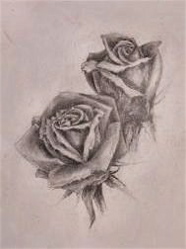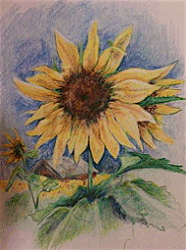The Classroom
Materials: Graphite & Colored Pencils

Believe it or not, the common pencil has never been made of lead. Because the black graphite core exhibited similar qualities, it was called plumbago, which means "acts like lead."
Graphite was discovered in 1564 in Borrowdale, England where the black carbon was originally used for marking sheep. Due to it's remarkable ability to deposit color, some of the first pencil casings were made of sheepskin. Borrowdale graphite was so pure that it could be cut into sticks for use with no additional refining required. Pencils were manufactured this way until the 1860s.
Modern pencils are composed of a mixture of powdered graphite and clay. The mixture is formed into it's final diameter before being fired in a kiln and then cut to length.
Today, a pencil core is still referred to as a "lead" but the casings are no longer made from sheepskin. Most pencils are encased in cedar, although some manufacturers are still using rainforest wood.
Pencils are available in varying degrees of hardness from 9H to 9B. Harder grades designated by the letter "H" have a higher mixture of clay and produce lines that are light and thin. Hard leads are ideal for detail work, as the fine lines and are less prone to smudging than softer leads.
Softer grade leads are designated with the letter "B" and draw thicker, darker lines that blend easily with tissue, stumps, or tortillons. Soft leads contain less clay than their harder cousins. Soft leads are designated by the letter "B" (instead of an "S") to convey how much black the lead will deposit on the paper. A hardness rating of "HB" indicates a standard #2 pencil.
A pencil drawing may be a completed work, or just a quick sketch. Loosely rendered value drawings are called sketches. They don't contain alot of detail, and are commonly used as reference material for a future piece. Value sketches may be referred to as thumbnail sketches or just "thumbnails." They're most useful when working with photographs taken at the same location. A painting can be blocked in quickly from the value sketch, and the details rendered from the photos.

Colored pencils were originally introduced during the 19th century. They weren't originally invented as a fine art medium, and contained relatively little pigment compared to today's colored pencils. As their popularity grew, so did the demand for better quality pencils.
During the 1920's, manufacturers began formulating highly pigmented soft leads especially for artists. Today, manufacturers produce high quality, lightfast pencils in very intense colors. These aren't your grandaddy's colored pencils. They can be used as a drawing medium, blended like soft graphite, layered similarly to pastel, or dissolved with solvent. Colored pencil can be used over a watercolor wash, and adding some pen-and-ink details can produce dramatic results.
Some brands of colored pencils are softer than others. The density of the binder remains constant, and it's mixed with different color pigments. The varying degrees of hardness are determined by the type, and amount of binder used. This varies by manufacturer, and there is no standard hardness rating similar to that developed for graphite.
Wax, oil, or water-soluble gum can be used as binders, each having it's own unique qualities. Wax based pencils can leave a "wax bloom" on the drawing. To prevent this, use a fixative when working with wax based colored pencils.
Water soluble pencils can be used either wet or dry. When wet, they behave similarly to watercolor paints and an appropriate support should be used.